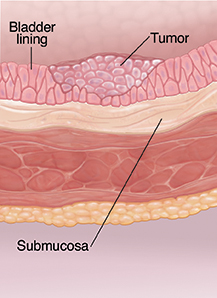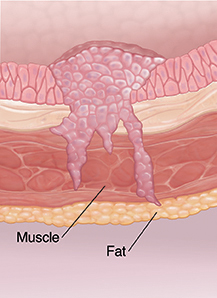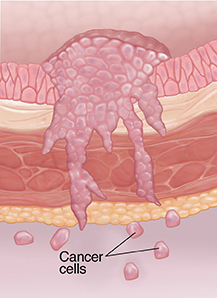Staging of Bladder Cancer
Once your healthcare provider knows you have bladder cancer, the next step is to find out the stage of the cancer. The stage is how much cancer there is and how far it has spread in your body. Tests and scans are used to find out how deep the cancer has grown into the bladder wall and if it has spread beyond the bladder. Staging is important for deciding how to best treat the cancer.
Stage: How much the cancer has grown and spread
As cancer cells multiply, the tumor grows. Bladder cancer starts in the inner lining of the bladder. It often doesn’t grow beyond that layer. But as the tumor gets bigger, it may grow into deeper layers of the bladder wall. It may also spread to nearby organs, such as the prostate or the uterus.
Cancer cells can also break off from the main tumor and go into the bloodstream or lymph nodes. Blood or lymph then carries the bladder cancer cells to other parts of the body, most often the bones, liver, or lungs, where a new tumor may form. (This is called metastasis. When in happens, it's called metastatic bladder cancer.)
 |
| At the superficial stage (noninvasive), the tumor is only in the bladder lining and submucosal layer of the bladder. |
 |
| At the invasive stage, the tumor has begun to grow into the muscle or fat layers of the wall of the bladder. |
 |
| At the metastatic stage, cancer cells from the main tumor have spread beyond the bladder to other parts of the body. |
The stage of cancer is based on where the cancer is and how much it has grown and spread. The stage is found by looking inside the bladder during cystoscopy and doing imaging tests that show the bladder, the areas around it, and parts of the body that the cancer may have spread to.
The staging system described here is a simplified one. Your healthcare provider will most likely use a staging system that's much the same, but more detailed.
The TNM system used for bladder cancer
The most commonly used system to stage bladder cancer is the TNM system from the American Joint Committee on Cancer. Staging is very important for deciding what treatment to use. Be sure to ask your healthcare provider to explain the stage of your cancer to you in a way you can understand.
The first step in staging bladder cancer is to find the value for each part of the TNM system. Here's what the letters stand for in the TNM system:
-
T tells how far the main tumor has spread into the lining of your bladder wall and if it has grown into nearby tissues.
-
N tells if the lymph nodes near the bladder have cancer cells in them. Lymph nodes are part of the immune system.
-
M tells if the cancer has spread ( metastasized) to other parts of the body, like the liver, lung, or bones.
Number values are assigned to the T, N, and M categories. There are also 2 other values that can be assigned:
-
X means the provider doesn't have enough information to tell the extent of the main tumor ( TX), or if the lymph nodes have cancer cells in them ( NX). This value is often assigned before surgery.
-
0 means no sign of cancer. T0 means the main tumor hasn't been found. N0 means there's no sign of cancer in lymph nodes.
Stage groupings of bladder cancer
The T, N, and M values from the TNM system are used to put these cancers into stage groupings. The groupings give an overall description of your cancer. A stage grouping is listed as a Roman numeral and can have a value of I (1), II (2), III (3), or IV (4). The higher the number, the more advanced the cancer.
These are the stage groupings of bladder cancer and what they mean:
Stage 0. Cancer is only in the inner lining of the bladder. It has not spread at all. It's 1 of these:
-
Stage 0a or non-invasive papillary carcinoma. The tumor is growing toward the inside of the bladder on a stalk (like a group of long, thin mushrooms).
-
Stage 0is or flat, noninvasive carcinoma or flat carcinoma in situ(CIS). The tumor is growing flat along the inner lining of the bladder, but not deeper into the bladder wall.
Stage I. The cancer has grown into the layer of tissue under the lining of the bladder. It has not reached the deeper muscle layers. It has not spread anywhere else.
Stage II. The cancer has spread into the deeper muscle layers, but not through them to the fatty tissue that's around the bladder. It has not spread anywhere else.
Stage III. The cancer might have grown into the prostate, seminal vesicles, uterus, or vagina. It has not grown into the pelvic or abdominal wall. It has not spread to parts of your body far away from your bladder. It also falls into 1 of these 2 sub-groups:
-
Stage IIIA. The cancer has grown through the muscle layers and into the layer of fat around the bladder. It may not be in lymph nodes or is in only 1 nearby lymph node in the pelvis that's not near the main blood vessels.
-
Stage IIIB. The cancer has grown into any of the layers of the bladder and/or the fat around the bladder. It's also in 2 or more pelvic lymph nodes or it's in 1 or more lymph nodes along the main blood vessels in the pelvis.
Stage IV. This stage is divided into 2 groups:
-
Stage IVA. The cancer has grown from the lining through the bladder wall and into the wall of the pelvis or abdomen. It might be in lymph nodes that are nearby or far from the bladder. It has not spread to other parts of your body far from your bladder.
-
Stage IVB. Cancer might have grown through the bladder wall and into nearby organs. It might also be in nearby lymph nodes. The cancer has spread to organs far from your bladder, like your bones, liver, or lungs.
Talking with your healthcare provider
Once your cancer is staged, your healthcare provider will talk with you about what the stage means for you. Ask any questions and talk about your concerns.